I believe that they do and this Rough-legged Hawk is a case in point.
Several raptor species drop prey or food for known behavioral reasons – male Northern Harriers drop prey in flight to their mates who have come up from the nest to catch it in midair and Bearded Vultures deliberately drop big (up to 9 lb) bones on rocks to break them open so they can get at the nutritious marrow.
But here I’m talking about something else – a raptor in flight with prey that has every intention of keeping and eventually eating that prey, but suddenly and deliberately drops it. Most raptorphiles have seen birds drop prey more than once (as I have) but the question becomes – was it accidental or deliberate. And if it was deliberate, why did they drop it?
I believe it’s often deliberate and they usually do it when the prey is a rodent that’s still alive and is biting the feet or legs of its captor. Those little rodent incisors are nasty and they can inflict significant pain and damage.
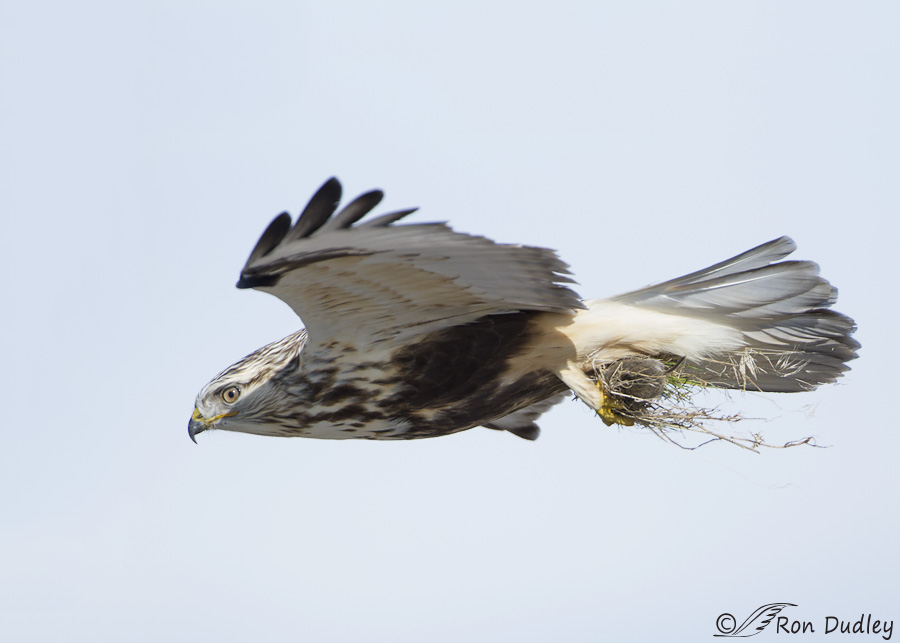
1/1600, f/6.3, ISO 500, Canon 7D, Canon EF 500mm f/4L IS USM + EF 1.4 III Extender, canvas added for composition, not baited, set up or called in
Here’s a Rough-legged Hawk with a vole it has just snatched along the causeway to Antelope Island. The bird picked up so much plant debris with the vole that the rodent is a little difficult to make out but its tail can be clearly seen along with the round ball of mammal fur.
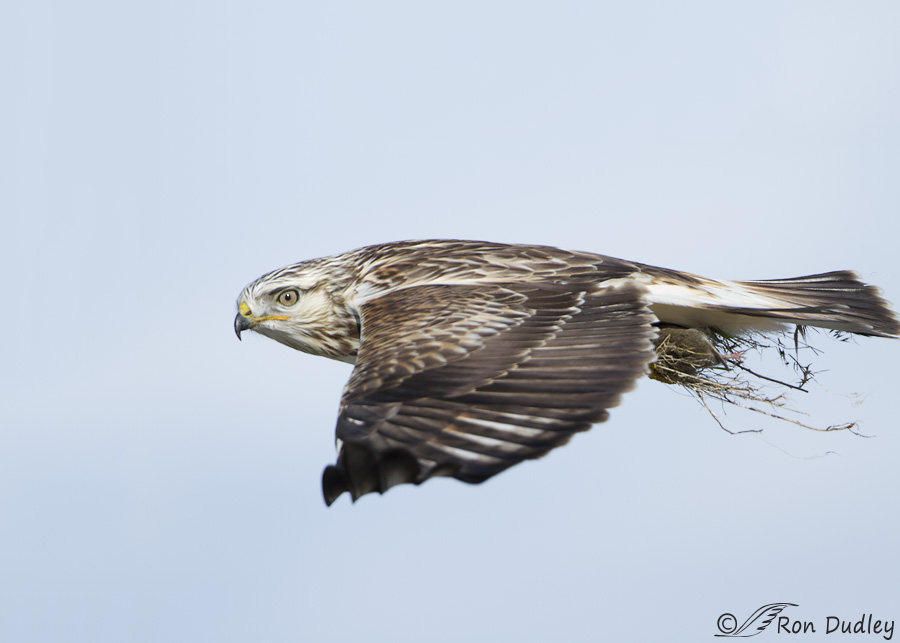
1/1600, f/6.3, ISO 500, Canon 7D, Canon EF 500mm f/4L IS USM + EF 1.4 III Extender, canvas added for composition, not baited, set up or called in
Six frames later the hawk still has the vole clutched firmly in its talons but the question becomes – was it still alive?
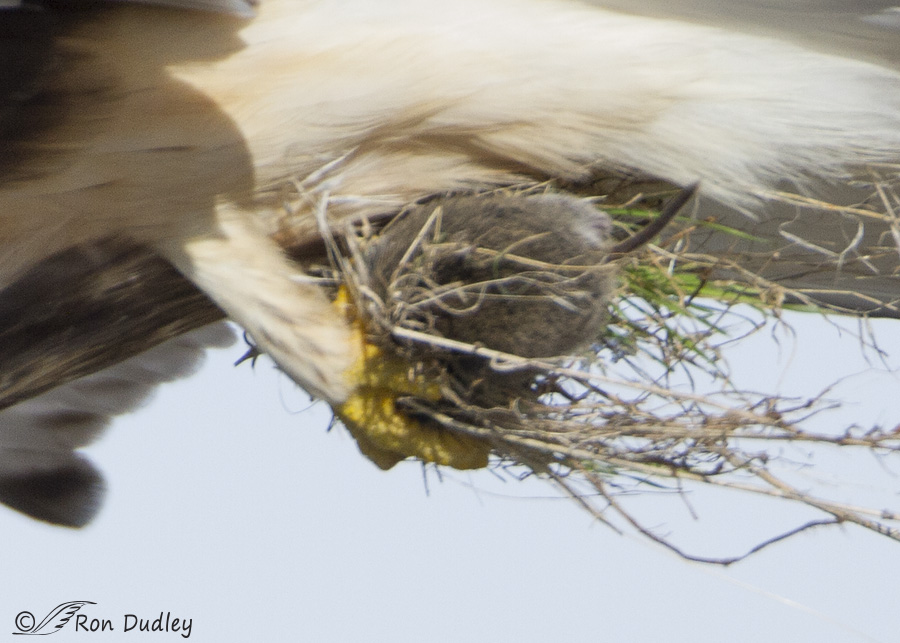
When we compare huge crops of the two previous images I see evidence that strongly suggests that it was still alive. Here its tail is pointing upwards at an angle and we don’t see any feet but…
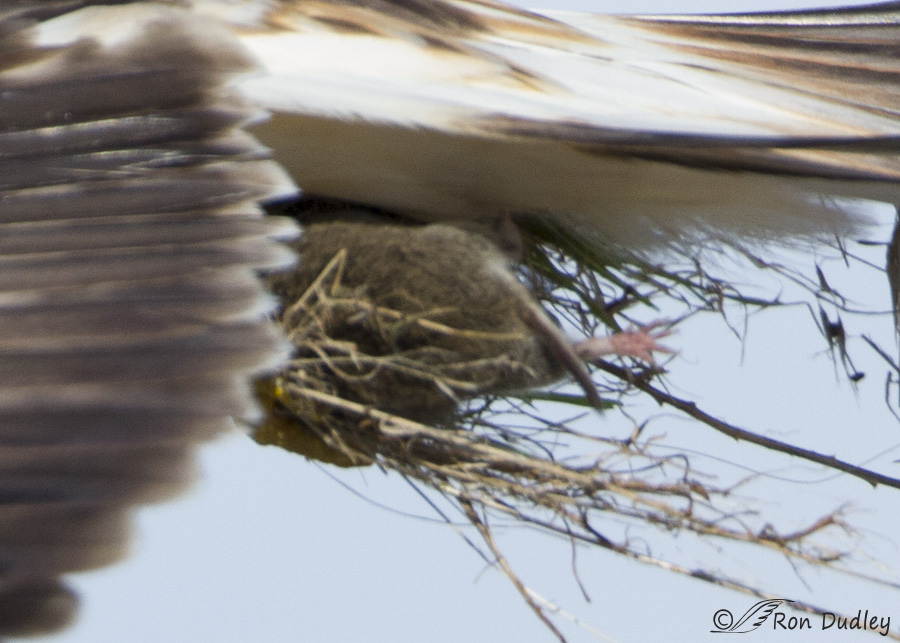
in the second image the tail is at a decidedly different angle and we now see one pink little foot stretched out behind. To me this strongly suggests the rodent was still alive and struggling and, as rodents are prone to do, probably attempting to bite the foot that held it. We’ll never know for sure but…
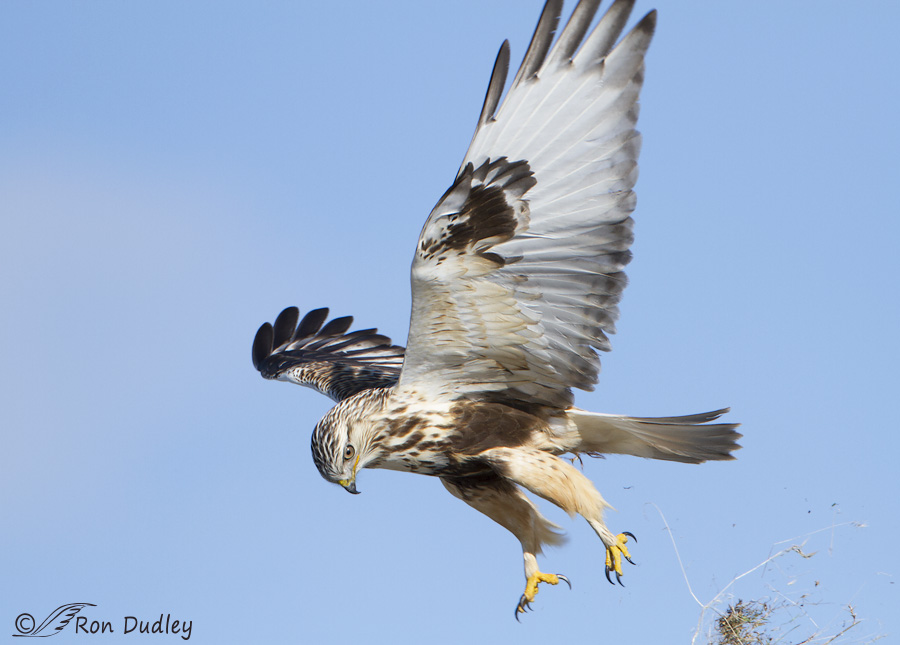
1/2000, f/6.3, ISO 500, Canon 7D, Canon EF 500mm f/4L IS USM + EF 1.4 III Extender, not baited, set up or called in
four frames later the hawk did drop the vole and its posture (legs extended down and talons spread widely open) tells me that it was done deliberately – probably because the vole was biting the hawk’s foot.
It kills me that the vole is just outside the frame. I’d dearly love to have had both the hawk and the falling rodent in the image but I was very close to the bird and lucky to get what I did.
From what I gather it’s common for prey (rodents especially) to bite and even damage raptor feet and legs. Rehabbers and bird banders often tell stories about birds in their possession that show wounds that have been caused by such encounters with rodents. I suspect falconers could tell similar stories.
If I ate voles and one in my hand was biting me I’d drop it in half of a heartbeat – no matter how hungry I was. I’ve been bitten by small rodents several times over the years and it isn’t an experience I want to repeat.
Ron
Notes:
- I don’t remember if this hawk went after the vole again after it was dropped. This incident occurred 5 years ago and I have a hard time remembering where I put my phone half an hour ago…..
- Raptors aren’t the only predators that are bitten by rodents. Twice I’ve documented voles biting coyotes – if you’re interested, those posts can be seen here and here.


Love the pics and information on this post!
He is watching like he still has an interest, nice series.
Great shots, and interesting behavior analyzation! Reading your blog I can never notice half the things you do going through your photos…
Levi, I’ve trained myself to look for that stuff, both in the field and in my photos. Noticing details, both physical and behavioral, is interesting and often exciting for me. It’s all part of being what I call a “watcher” and the satisfaction I get out of it is immense.
The look of what I perceive as “OUCH you little….” cracks me up.
🙂
Fascinating series. I wonder how the vole fared the drop — and landing. The dropping shot with the wings and talons in such interesting positions is pretty darn cool! I had a classroom snake for many years who was none too swift with the mice and was bitten quite often. Even with the bites, he wouldn’t take frozen or “previously dispatched” mice no matter how much I made them wiggle.
As far as the phone goes, I often find mine in a cupboard. Or the linen closet. Or the refrigerator. Once, the microwave (took out the food and put in the phone — fortunately, did not turn it on). I blame all those years of teaching high school — dang kids stole my brain (and made my hair turn grey)! 😉
Marty, It embarrasses me but when I lose my phone I occasionally have to ask someone else in the house (or even a neighbor) to call me so I can track the damn thing down from its ring…
Don’t feel like the Lone Ranger(s) in losing your phone (glasses, keys, etc.). I SWEAR there are gremlins in the world who hide these things just for fun! 🙂
I have also been bitten by a rodent. In my case an ungrateful rodent which I had just taken away from a cat. It fanged the hand that saved it. Hard. Which hurt. And continued to hurt until I was in a safe place (for the mouse) and could let it go.
Not at all surprised that a raptor would drop a dinner with operational fangs. At least temporarily.
Great series.
EC, when someone is bitten by a rodent it’s usually an event they don’t soon forget. I sure haven’t…
What a terrific series Ron–yet again 🙂
I think the problem with your question is the word “ever.” I’ve found that concepts of always and never just don’t work with wild critters, and if there’s good reason to drop a meal (as with rodent incisors digging into their feet), they’ll do it. We humans often tend to view wild critters (and humans, too) in monolithic terms and behavior happens when it’s necessary to happen. That’s just my take on things.
In my personal experience, Mariah (FRTHA) learned to catch squirrels when she was an adult. By that time, she’d learned that a head shot was the only way to go, and with the big Texas fox squirrels, if she missed the head shot, she’d drop the squirrel and make another pass at it to get that head shot. She is a smart old hag who’s now 24 years old…LOL!
Laura, here’s an interesting comment once made by Louise Shimmel in that regard (falconry birds and squirrels):
“many falconers who use their birds to hunt squirrels train the birds to wear leather ‘chaps’ on their legs and to protect the top of their feet from those very powerful squirrel teeth”
Gary Brewer, who lives in East Texas (where there are nothing but squirrels to hunt), developed those squirrel chaps. At the time (late 80s), falconers avoided squirrels like the plague since they’re so dangerous, but that’s what he had to hunt. So he devised a way to hunt them. Many falconers swear by them and many swear AT them…LOL! I never used them, primarily because I couldn’t manage putting them on and taking them off each day (although I could have also installed them with a grommet for a semi-permanent setting). Mariah was so intent on getting the head shot that I didn’t bother. She didn’t get any bites, either, although that could have been the luck of the draw. I’m in Arizona now where the quarry of availability is cottontails, jackrabbits and quail. I REALLY want to get her back out (she’s blind in one eye after her crash several years ago) but it looks like it will be next season before that happens.
Jack the Harris’ hawk should be out hunting shortly along with The Evil Princess (AMKE). That’s going to be about all I can manage with getting the move done and all.
And as you know, Louise ROCKS! 🙂
This is a great series, including the two posts of past shots of Coyotes and voles!
Makes sense that prey would bite a predator if they can.
A Coyote will still go after the vole when it has been bitten, hard to believe a bird of prey wouldn’t do the same thing unless it is trying to get away from a threat.
Many thanks for these wonderful series.
Dick, it would be my guess that the hawk went back down after the vole after it was dropped but this long after the event I sure don’t remember seeing it do so.
Fantastic pics!
Thanks, Nicole.
Very interesting series. It definitely makes sense that the bird would drop its prey deliberately if it was being bitten. I also found Dick Ashford’s comment very interesting; I went back and looked at the cropped photo, and could also see that foot, pushing against the bird’s body. I’m guessing that there are ways to pick up a vole to where it couldn’t bite, but that would definitely take a lot of practice, and probably be difficult to do even then, since catching one has to be done very quickly. Glad I don’t have to hunt and eat voles…
“Glad I don’t have to hunt and eat voles”
My thoughts exactly, Susan!
Hi Ron,
Wonderful. I have seen this on a few occasions, and wondered about it.
Here is more food for thought: by zooming in on the closeup view where one can see the foot, I believe I can see its other foot in a position that appears to be pushing the rodent away from the bird. If so, and if the hawk’s talons didn’t quite have “enough” of the prey, perhaps the vole could have freed itself. And, this is appears to be a young roughie – maybe it was still learning how to do the deed…? I haven’t kept records, but the memories your images evoked were of immature Red-tailed Hawks dropping prey. As they say, “more study is required”. I love this stuff! Thanks, as always, for allowing us to see the natural world up close and, more importantly, to think about what we’re seeing.
Cheers,
Dick
“perhaps the vole could have freed itself”
Perhaps, Dick, but that’s not the bet I’d make. Those spread-eagle talons and legs extended down in the last shot suggest strongly to me that the hawk couldn’t get rid of the vole fast enough.
It’s interesting to speculate though.
Critters RARELY escape the grasp of a raptor. That grasp is pretty significant–trust me on this. I’ve been grabbed. 🙂
Great series! Those voles/mice etc. do bite anything that dares to latch on to them or indicate they’re going to latch on to them! I’ve watched a house cat and our dogs get “educated” about them! 🙂
When the consequences are pain and often blood the lesson is usually learned very quickly!
Don’t try it……
🙂
Over the last month, I have observed the same red-tailed hawk apparently land on its target, than stomp around in the weeds for a minute or so before leaving with empty talons. I wonder if the voles/ground squirrels were fighting and biting. That makes a lot of sense from the behavior I observed.
I often see that same behavior, Pam. Sometimes it pans out for the bird and sometimes it doesn’t.
I can’t help thinking that all that stomping is just a temper tantrum out of frustration for missing the meal! 🙂
Marvelous shots and interesting observations Ron!
Charlotte
Thanks, Charlotte.
Ron, those gulls that pick up voles while following a plowing tractor certainly dropped their would be dinners intentionally to take the fight out of them.These voles were being held in the gulls beaks since they didn’t have talons and they were very much alive and fighting. In a college immunology lab, I saw many mice get dropped or bounced off a wall after they latched onto a handler’s finger.
“or bounced off a wall after they latched onto a handler’s finger”
Marvin, as you know their teeth are powerful and long for the size of the animal so when they bite they really hold on. To get them off your finger your instinct is to shake your hand violently which often flings them far away in random directions. Get’s your attention!
I worked in a rat lab for a while and can definitely feel this roughie’s pain!
WOW! That is a great series of photos! I do believe you are right about the vole biting the hawks leg. I love your photos and comments to go along with them. 🙂
Thanks, Jerilyn. Sure wish I’d have caught the falling vole in the last image but I still think it conclusively documents the behavior.